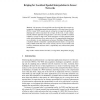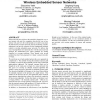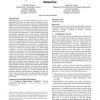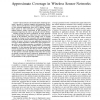179 search results - page 3 / 36 » On Solving Coverage Problems in a Wireless Sensor Network Us... |
SSDBM
2008
IEEE
14 years 4 days ago
2008
IEEE
Abstract. The presence of coverage holes can adversely affect the accurate representation of natural phenomena being monitored by a Wireless Sensor Network (WSN). Current WSN resea...
SENSYS
2003
ACM
13 years 11 months ago
2003
ACM
Sensor networks not only have the potential to change the way we use, interact with, and view computers, but also the way we use, interact with, and view the world around us. In o...
ISCC
2005
IEEE
2005
IEEE
Preserving Area Coverage in Wireless Sensor Networks by Using Surface Coverage Relay Dominating Sets
13 years 11 months ago
— Sensor networks consist of autonomous nodes with limited battery and of base stations with theoritical infinite energy. Nodes can be sleep to extend the lifespan of the networ...
MOBICOM
2006
ACM
13 years 11 months ago
2006
ACM
Although most wireless terrestrial networks are based on twodimensional (2D) design, in reality, such networks operate in threedimensions (3D). Since most often the size (i.e., th...
LCN
2005
IEEE
13 years 11 months ago
2005
IEEE
— Recent advances in microelectronic technology have made it possible to construct compact and inexpensive wireless sensors. Sensor networks have received significant attention ...




